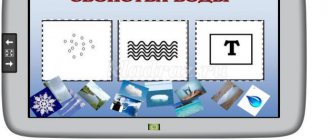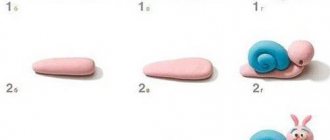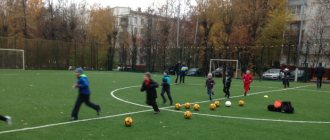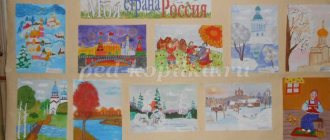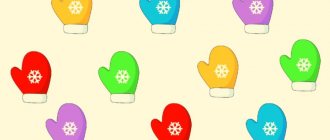Game 1. “Exchange”
In the store, children see you take money out of your wallet. Will they be able to raise the required amount themselves? The first game will teach your child to distinguish coins, change banknotes and collect the same amount in different ways.
How to play
You probably have a lot of loose change. Pour it onto the table and tell your child what types of coins there are. Let us look at them, compare size, weight, color, thickness.
Do the same with banknotes.
Explain that money is a constructor. We collect from them the amount that we give in the store for purchases. Show your child how it works: for example, collect 10 rubles from coins in several different ways (from coins of 1 ruble, 2 rubles, 5 rubles, etc. - the combinations can be different).
Now invite your child to “change” your money. Let him change you 10 rubles, 50 rubles, 100 rubles in coins.
Result
This game will teach your child to recognize and count money. Want to make the process more exciting? Invite your child to collect different combinations of the same amount of money at speed.
Didactic games in economics for older preschoolers with goals
Card index of didactic games on the economic development of children of senior preschool age 5-7 years.
The material will be useful to preschool teachers of any type who implement gaming technology in their work.
Game “Train of Coins and Banknotes” Purpose: to teach how to build a sequence of increasing and decreasing the value of coins and banknotes. Material: A set of coins for each child for practical activities, a “train of coins and bills”, where children can arrange coins and bills in increasing and decreasing sequence; Progress of the game: - A “train of coins and bills” came to visit us. What kind of cargo do you think he is carrying? (coins) - Correct, but the coins on this train are located in a certain order. The first carriage carries a coin of the highest denomination. Look at your coins, which coin can travel in the first carriage? - Let's put a 5 ruble coin in the first carriage, what coin will go in the next carriage? Next, the children distribute the coins among the cars in descending order of denomination. - What coin is in the last carriage? This means that this coin is of the lowest denomination (1 kopeck). You can ask the children questions about this task: Which coin is in the carriage between 1 kopeck and 10 kopecks? - Guys, is it possible to distribute banknotes among the carriages in the same way (children distribute banknotes among the carriages). Game “If..., then...” Goal: introduce the following concepts into the active vocabulary: “grocery store”, “manufactured goods store”, learn to differentiate concepts, find similar and distinctive features; Clarify children's ideas about different types of stores. Progress of the game: - Guys, I will tell you a sentence, and you will have to continue this sentence, for example, “If you go to a grocery store, what can you buy there?” • If you go to a shoe store, what can you buy there? • If we go to a clothing store, what will we buy there? • If we go to a furniture store, what will we buy there? • If you go to a grocery store, what can you buy there? • If you go to a department store, what can you buy there? The game “What is sold where?” Goal: to learn how to distribute items for sale in different types of stores. Material: pictures depicting various types of goods. Progress of the game: - Look, guys, here we have a lot of goods that you can buy in the store. In which store can you buy these products? We look at pictures with children depicting goods (bread, loaf, sausage, skirt, shampoo, washing powder, toothpaste, jacket, and others). Together with the children, we determine which store sells the presented product. Game "Expensive - Cheap". Goal: to teach children to correlate the price and quality of a product. Material : morphological table with the names of different types of stores and products sold in them. Red signs indicate expensive goods, blue signs indicate cheap goods. Progress of the game: - Look, guys, we have various goods here. And I have such interesting signs - blue and red - the blue sign indicates a cheap product, and the red sign indicates an expensive product. What do you think is the most expensive and cheapest product? Lay out the signs. — Place red signs near expensive goods, and blue signs near cheap goods. Why did you decide so? Game “Shop” Purpose: to teach children to practically carry out the actions of purchasing goods, to say out loud the phrase “WORTH IT,” “I’M CRYING,” “CHANCE.” Material: small goods or illustrations of goods, price tags; money to buy goods for each child, product catalogs, price tags. Progress of the game: - Guys, let's play shop. - What do we need for this? — The right product, put price tags on the product, put it on the shelves. Together with the children, we determine the prices of goods, write price tags, and arrange goods on shelves.
We choose a seller or the teacher himself can play this role at the beginning of the game. We require the following sequence of questions and answers from children: - What, Masha, do you want to buy?
— I want to buy milk. It costs 12 rubles. I give you 15 rubles. - Here's 3 rubles in change. We interview several children. Then you can change the seller. Game "Auction" Purpose : to teach children to establish a connection between price, cash amount and change. Material : small goods or illustrations of goods, money. Progress of the game : All children are given money to purchase goods.
- Look, guys, I have a beautiful teddy bear in my hands.
Who wants to buy it? — The bear costs 5 rubles. - Who will buy Mishka? -There are many people who want to buy the Bear, then I add the price. The bear costs 6 rubles. Who has that amount of money? Next, we sell a few more toys to the children. You can use the word “Cost” (What is the cost of Mishka?) to introduce it into the child’s active vocabulary. Outdoor game “Find a Pair” Purpose : to teach children to establish the relationship between the dignity of money. Material : coins and bills of different denominations (one set of coins and bills for each child). Progress of the game: Children dance to the sound of music; when the music stops, children must find a pair according to the value of the coins. A pair consists of children, where one has a coin of a lower denomination, and the other has a coin of a higher denomination. Game "What does it do?" Goal : Clarify the names of such professions as doctor, teacher, driver, artist; strengthen children's ideas about professions. Progress of the game: - I will tell you the profession, and you will name what the person does. Cook - cooks porridge; Turner – makes parts; Doctor – treats people; A teacher teaches children; Driver – drives the car; Seller – sells products and goods; — What other professions do you know? What do people in these professions do? The game “Who works where?” Goal : learn to establish a connection between a person’s place of work and profession. Progress of the game: - Works in the police... - Works in a store... - Works in a bakery... - Works in a taxi... - Works in a fire department... - Works in a school... - Works in a hospital... You should draw the attention of children to what can be called not one profession, but several: Doctors, nurses, cleaners, cloakroom attendants, etc. work in the hospital. Game "Shop". Goal : - consolidate the concept of “store”, various types of stores; — introduce the rules of behavior in the store; — practically consolidate the rules of behavior in the store in a gaming situation; — cultivate a culture of behavior in public places; Material: Products for sale, price tags, display cases, supposed cash register, money for purchasing goods. Progress of the game: Together with the children, we decorate the store windows and paste the prices of the goods. Organize 3 children to work in the store itself. The first child is a cashier, sits at the register and punches out checks. Two children play the role of sellers: they offer children - buyers the goods presented in the store. It is important that children follow the rules of behavior in the store when purchasing goods. If the rules are not followed after the game, comment on the mistakes without getting personal, but identify typical mistakes. After some time, you can change the sellers so that they can demonstrate the rules of behavior in the store. Behavior rules. — When you come to the store, how should you behave? — What rules of conduct exist in public places? • You need to walk around the store floor quietly and calmly. You can talk in a low voice, consult with each other. Why? • In a store, you need to carefully examine the products on the shelves, choose the product you like, find out its price, check how much money you have in your wallet, and then make a purchase decision. Why? • If necessary, you need to seek advice and find out how to use the chosen item. Preference should be given to quality products. Why? • Do not forget when talking with the seller and cashier about words such as “thank you”, “please”, etc. • When talking with the seller, be patient, do not interrupt, listen to the end. • Having made a firm decision about what product you will buy and remembering its price, go to the cashier, pay for the purchase, and receive a receipt. • Go to the seller with the receipt and explain what toy you are buying. • Check again the quality of the purchased item: whether it has any breakages or whether its appearance is spoiled. Why? • Remember what words to thank the seller. Questions will help children discover the essence of some rules and understand their importance and necessity. The teacher explains some rules to the children himself, and some can be asked to explain to the children.
We recommend watching:
Economic education of preschool children Notes on economics in the senior group of a preschool educational institution Essay by a kindergarten teacher. Formation of financial literacy in preschool children Introductory course on teaching the basics of financial literacy to children of the middle group of preschool educational institutions
Similar articles:
About the profession of a banker for children
Game 2. “Shop”
Now the child knows that any amount can be added up from different money. What to do with this money? That's right - go to the store and pay for your purchases.
Practice going to the store at home.
How to play
Just like in childhood, only instead of leaves, take real coins and small bills.
Place “goods” on the table: toys, food from the refrigerator. Attach a price tag to each product. Agree who will be the “seller” and who will be the “buyer.”
If the “buyer” is a child, then he will have to collect the required amount of bills and coins and give it to you in exchange for the goods. If the amount is more, let him wait for the change. Then switch roles. Now the task of the child “seller” is to check whether you gave him the money correctly. And if necessary, return the change.
Result
This game teaches the child the basic principle of commodity-money relations: in order to acquire something, you need to pay for it. The seller will receive this money and use it to develop his business - buy new products or improve those he is currently selling.
Financial vocabulary for kids
- A bank is a place where people can carry out various transactions with money.
- Deposit is money that was brought to the bank and given to be kept there.
- An ATM is a device that allows you to withdraw or deposit money onto a bank plastic card.
- Assets are anything that brings in money.
- Liabilities are what take money.
- Money is pieces of paper or coins that serve as a general exchange. For example, for money you can buy anything in a store, or go to the movies. Different countries have different money.
- Card - fully called a bank payment card. This is a piece of plastic that you can use to pay for purchases in stores, online, and many other places.
- A loan is money that a person, if he lacks for something, can ask to borrow from a bank. For example, if you want to buy a computer, but you don’t have enough money, the bank can lend you money. But then the bank will have to repay the debt and pay interest.
- A bill or banknote is what paper money is called. A bill or banknote is one piece of paper.
- Cash flow or profit is the difference between income and expenses over a period of time.
The following types of coins and banknotes are currently in use in Russia:
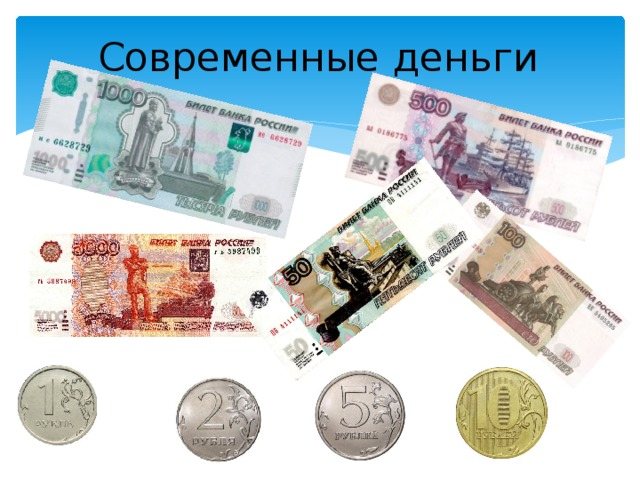
Game 3. “Quest in the supermarket”
Previous games taught the child to distinguish money by face value and pay for purchases. It's time to test your knowledge in practice.
How to play
Invite your child to go to the store. Explain that this time he will be in charge: he will need to make sure that you bought all the planned goods and whether there was enough money for them.
1. Together with your child, make a shopping list and prepare the amount you plan to spend in the store.
Advice: let the shopping list not be long (maximum three or four items), and the amount of money not very large, so that it is easier for the child to navigate it (two hundred to three hundred rubles).
2. Walk around the store with your child. His task is to collect all the goods from the list and meet the planned amount. Draw your child's attention to the fact that goods from the same category (for example, milk) may cost differently. The price depends on the name of the manufacturer and the volume of goods.
3. Towards the end of the shopping trip, invite your child to buy an expensive item not on the list - for example, a box of sweets. If the child agrees, ask: does he have enough money? Of course, there is not enough money for everything. Then offer him options: either you refuse to purchase goods from the list and buy a box of sweets, or you put off the sweets for later and go to the checkout only with those purchases that you planned in advance.
Let the child choose.
Result
At the end of this game he will learn several things at once:
Firstly, he learns that before going to the store he needs to make a shopping list. This makes it easier not to add too much to your basket and waste all your money.
Secondly, he learns that the same goods can cost differently. And the most expensive product is not necessarily the best.
Thirdly, he learns that all purchases are divided into desirable and necessary. A box of sweets is a desirable splurge. Sweets are delicious, but if you have milk and sunflower oil at home and don’t have much money with you, you can do without sweets. That is, in this case, a box of sweets is a desired purchase, and milk and sunflower oil are necessary.
The fourth lesson is waiting for him at the checkout. The child will have to pay for purchases and check the change that the cashier will give him. Invite your child to keep the change. He can spend it on a toy or something tasty, or he can put it in a piggy bank.
Hurray, the quest is completed. Repeat it periodically with your child - this way he will soon learn to be smart about spending.
Financial literacy for preschoolers
Game index
on financial literacy
for children 5-7 years old
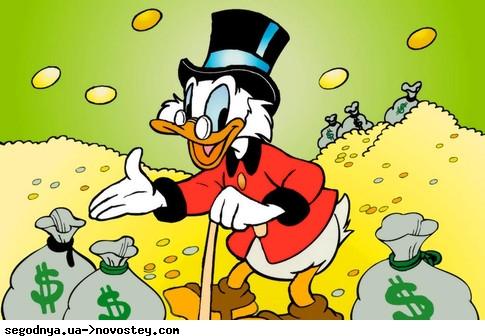
It is necessary, through games and practices, to convey to children that:
- Money does not appear by itself, but is earned!
We explain how people earn money and how earnings depend on the type of activity.
- First we earn, then we spend.
We tell you that “you can only take out of your nightstand what you put in it” - accordingly, the more you earn and spend more wisely, the more you can buy.
- The cost of a product depends on its quality, need and how difficult it is to produce.
We explain that the price is the amount of money that must be given, and the product in the store is the result of the work of other people, so it costs money; people seem to exchange their labor for the labor of other people, and in this chain money is an intermediary.
- Money loves counting.
We teach you to count change and generally count money quickly and carefully.
- Finances need to be planned.
We teach you to keep track of income and expenses in the short term.
- Your money can be the object of someone else's interest.
We agree on the key rules of financial security and who to contact in case of emergency.
- Not everything is bought.
We instill an understanding that the main values - life, relationships, the joy of loved ones - cannot be bought with money
.
- Finance is interesting and exciting!
Game "Pear-Apple".
Target:
teach how to count money and resources.
Necessary materials:
paper, pencils, scissors.
The essence of the game:
Invite your child to draw a pear on one side of the paper. When the drawing is finished, offer to draw an apple on the back of the sheet.
When both drawings are completed, give your child a pair of scissors and ask them to cut out both the pear and the apple for you. When you see confusion, explain that, of course, this is impossible. Because there is only one sheet of paper, and if we initially wanted to cut out two designs, it was necessary to plan the place on the paper in advance.
Same with money:
they need to be planned in advance.
Game "Exchange"
Target:
teach counting money.
Necessary materials:
coins and banknotes of different denominations.
Number of participants:
1-5.
The essence of the game:
Give the children small coins, 2-3 tens each. And leave yourself several banknotes of different denominations. This is a competitive game. Whichever player quickly exchanges the banknote you laid out with change, gets the banknote. At the end of the game we count the winnings.
The game “Who works for whom?”
Target
. Using the example of fairy-tale characters, consolidate and expand your understanding of the profession. Cultivate a desire to explore the diverse world of professions, respect for the hard worker.
Material.
Riddle Doll, drawings with images of people of different professions and fairy-tale characters.
The essence of the game
Show the children pictures of people in different professions. Children, guided by the drawings, name the professions of their parents, their loved ones, and all those they meet.
Having received pictures from the cash register with images of fairy-tale characters, he asks to guess their professions.
Give the girls drawings depicting fairy-tale characters, and the boys with images of people of different professions. At the signal of the bell, girls and boys begin to look for their pair and sit down at the tables in twos, and then take turns proving the correctness of their choice. You can invite children to show the profession of their hero with the help of movements, imitations and other figurative actions.
Organize a gradual transition to role-playing games on this topic. You can also have conversations about how the hero feels about his work, who produces goods and who provides services (if children are familiar with these concepts).
The game “Who works what?”
Target
. Expand the idea that in fairy tales the heroes acquire wealth in different ways: some work, while others sometimes strive to get big money through unseemly deeds. Cultivate respect and affection for the kind and hardworking heroes of fairy tales.
Material.
The ladder consists of five steps; fairy-tale characters: Cinderella, Pinocchio, the old one from Pushkin’s fairy tale, Crete, Puss in Boots, Mowgli, Kotigoroshko, Krivenka Ducky, Goldfish, Naf-Naf, Grandma, Little Fox-sister, etc.
The essence of the game
Show the black box, the sun and the cloud. Ask for help in figuring out which fairy-tale heroes are more popular - hardworking or lazy?
For this purpose, draw a ladder on the board (a piece of Whatman paper), invite each child to take out a drawing depicting a fairy-tale hero from the black box.
Then introduce the rules of the game:
If the sun appears, all the hardworking heroes should be placed on the top step. And as soon as the sun changes into a cloud, children join the game, whose drawings depict lazy heroes. They need to be placed on the lower steps. Children prove the correctness of their choice.
The teacher helps children determine which proverbs and sayings are suitable for which fairy-tale characters:
“It works so well that you can even lie in the sun all day.”
“If you want to eat rolls, don’t lie on the stove.”
Children talk about how there are more hardworking heroes in fairy tales. After finishing the game, have a discussion about whether it is possible to help the lazy heroes of fairy tales become hardworking and how to do this.
Game Services and goods
Target
. To consolidate information about what services and goods are, to show that they are found not only in real life, but also in fairy tales. Cultivate respect for any work.
Material
. Subject, subject-based pictures depicting labor - the production of goods or the provision of services - in fairy tales: Little Red Riding Hood carries a basket of pies, the artist Tube draws pictures, Knopochka makes jam, Doctor Aibolit treats, Grandfather catches fish with a seine, Vintik and Shpuntik repair a car, postman Pechkin delivers letters, etc.; tables Products, Services.
The essence of the game
From behind the theater screen, you can hear the hero’s voice: guys, I decided to bake pies and sell them to the forest dwellers. Do you think I produce a product or provide a service?
The teacher and children clarify what goods are (these are different objects that are produced) and what services are (this is help that can be provided to another).
Children say what professions people produce goods: baker, farmer, shoemaker, artist, miner, weaver. Then they remember the professions whose representatives provide services: nanny, teacher, teacher, hairdresser, doctor, salesman.
In fairy tales, characters work the same way as people in real life. Place two tables Products and Services. Children attach corresponding drawings to the tables, explaining their actions:
-Mom bakes pies for grandma. Pies are a product that my mother made. But the granddaughter is bringing these pies to her grandmother. So, the girl provides a service.
-Vintik and Shpuntik are repairing cars. They provide services.
At the end, the children are read their favorite fairy tale and have a conversation about the topic of the game.
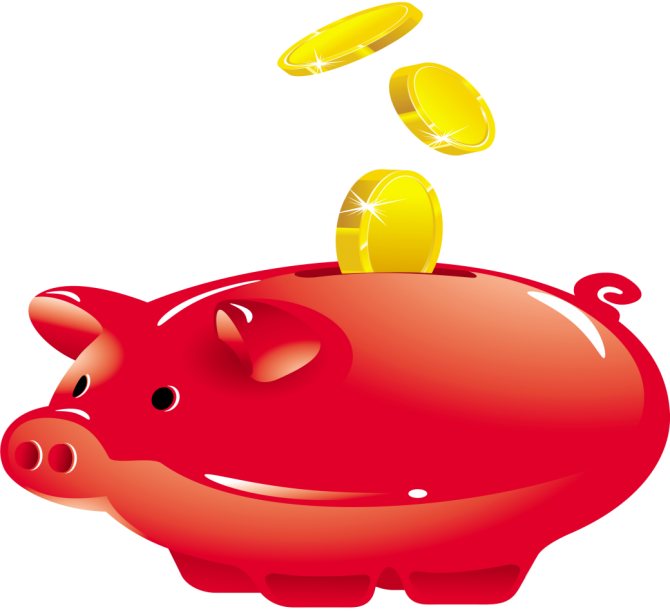
Practice "Mini-bank"
Target:
show the principles of financial planning, convey the principle “first we earn, then we spend.”
The essence of the practice:
Invite your child to create his own “mini-bank”. Let him be responsible for collecting and storing small items. Offer to remind all family members to “bank the coins” by emptying their pockets.
Offer to discuss what family business these coins in the “mini-bank” are collected for - for example, to buy a juicer or a board game. It should be something for common use so that the child feels proud of preparing such an important purchase for the family.
The next stage in the development of practice - you can tell your child that banks earn interest on storing money, and agree that some small percentage of the money available in the “mini-bank” will be given to him personally for working as a banker - for example, 3% or 5%.
Practice “Joint purchases”
Target:
show the principles of financial planning and wise purchasing, explain the origin of the cost of goods and the basis of financial security.
The essence of the practice:
Go shopping together regularly. Give your child the opportunity to choose the product from your list. Encourage your child to use a calculator to calculate the cost of all the items you put in the basket, and also check the shelf life of the products on the packaging. Discuss why the cost of similar products differs: due to the size of the packaging, for example, or is it different for each manufacturer.
At the first stage, ask him to find a specific product on the shelf and take it to the checkout, then unload it onto the belt, and then put it in a bag.
At the next stage, you can give a more complex assignment, for example, choosing everything for your own breakfast.
Over time, you will see when your child is ready to make simple, independent purchases.
Practice “Independent purchase”
Target:
show the principles of financial planning and wise purchasing, explain the origin of the cost of goods and the basis of financial security.
The essence of the practice:
When you understand that your child knows his way around the store well, feels confident near the cash register and is attentive to the prices of goods and getting change, offer him his first independent trip to the store.
Be sure to make a shopping list. The first time it should be simple, no more than three products: for example, bread, milk and cookies. Discuss what kind of purchases you are looking forward to: if milk, then what kind; in what packaging; with what shelf life? at what price.
Give an amount that requires change. Discuss what the change should be.
Praise your child for making a purchase!
Practice “Expense table”
Target:
teach how to count money, show the principles of financial planning.
The essence of the practice:
Teach your child to count the money he collected, earned and spent during the week, and then enter the resulting amounts into the table. These actions should become a habit.
Agree on a time in the daily schedule when the child will devote 10 minutes to this activity.


